Evidence-Based Nursing Research: Fall Risk in Older Adults
VerifiedAdded on 2023/06/04
|9
|2483
|303
Report
AI Summary
This report provides an in-depth analysis of a selected nursing research paper focusing on the risk factors associated with falls in hospitalized older adults. The study, published in the journal 'Health Expectations,' employed a qualitative research approach, including interviews with older adults, caregivers, and healthcare professionals. The research identified key themes, including enforced, voluntary, and uninformed risk-taking behaviors. Factors such as the older adults' ability to compensate, their willingness to seek help, and communication failures influenced these behaviors. The study's findings highlight the tension between risk-taking for rehabilitation and fall risk, emphasizing the role of healthcare professionals and caregivers in mitigating unnecessary risks. Recommendations include the need for broader application of the research and the importance of considering the perspectives of health professionals and the hospital staff's capabilities. This report provides a comprehensive overview of the study's methodology, results, discussion, and recommendations, offering valuable insights into fall prevention strategies for the elderly in healthcare settings.
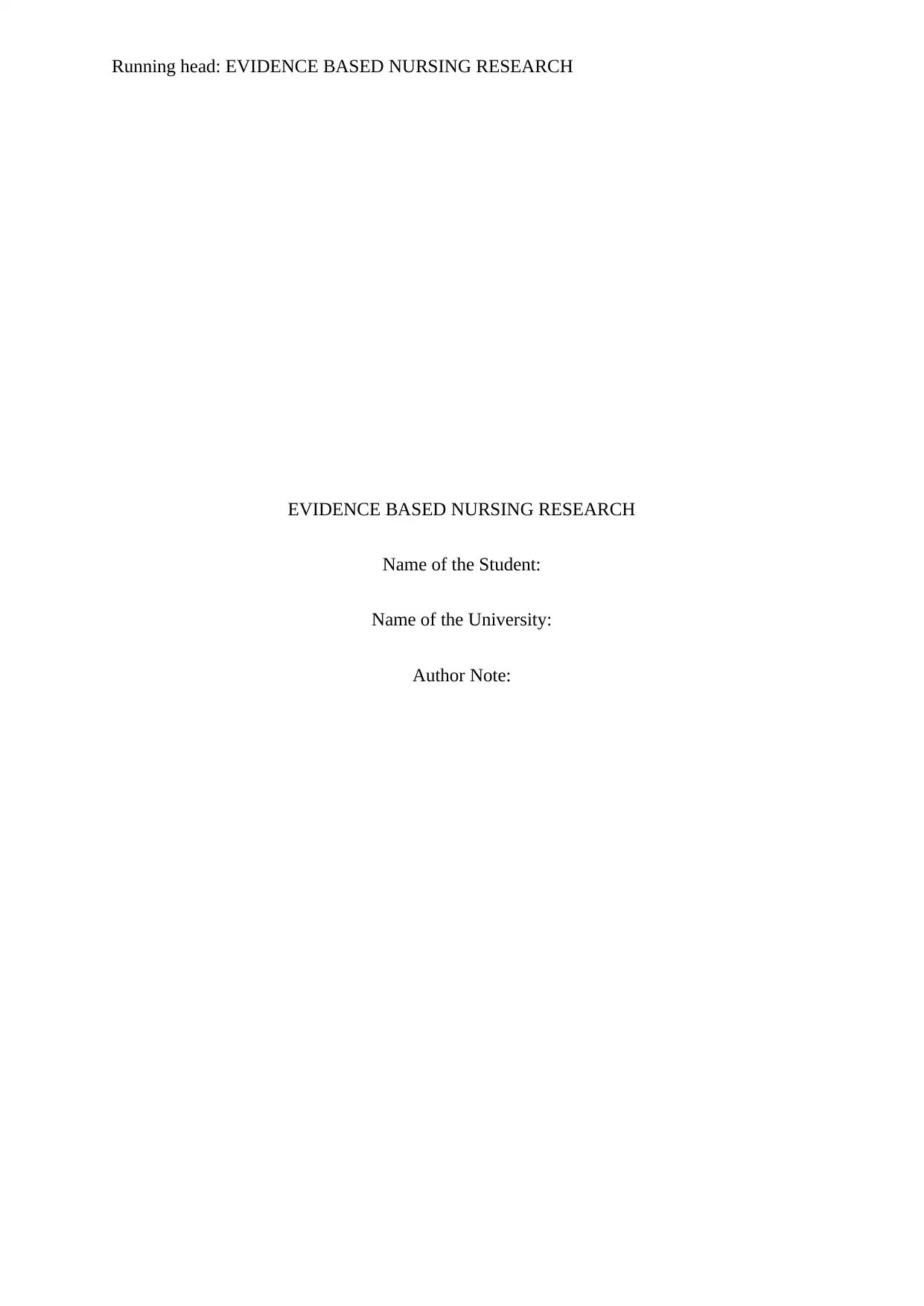
Running head: EVIDENCE BASED NURSING RESEARCH
EVIDENCE BASED NURSING RESEARCH
Name of the Student:
Name of the University:
Author Note:
EVIDENCE BASED NURSING RESEARCH
Name of the Student:
Name of the University:
Author Note:
Paraphrase This Document
Need a fresh take? Get an instant paraphrase of this document with our AI Paraphraser
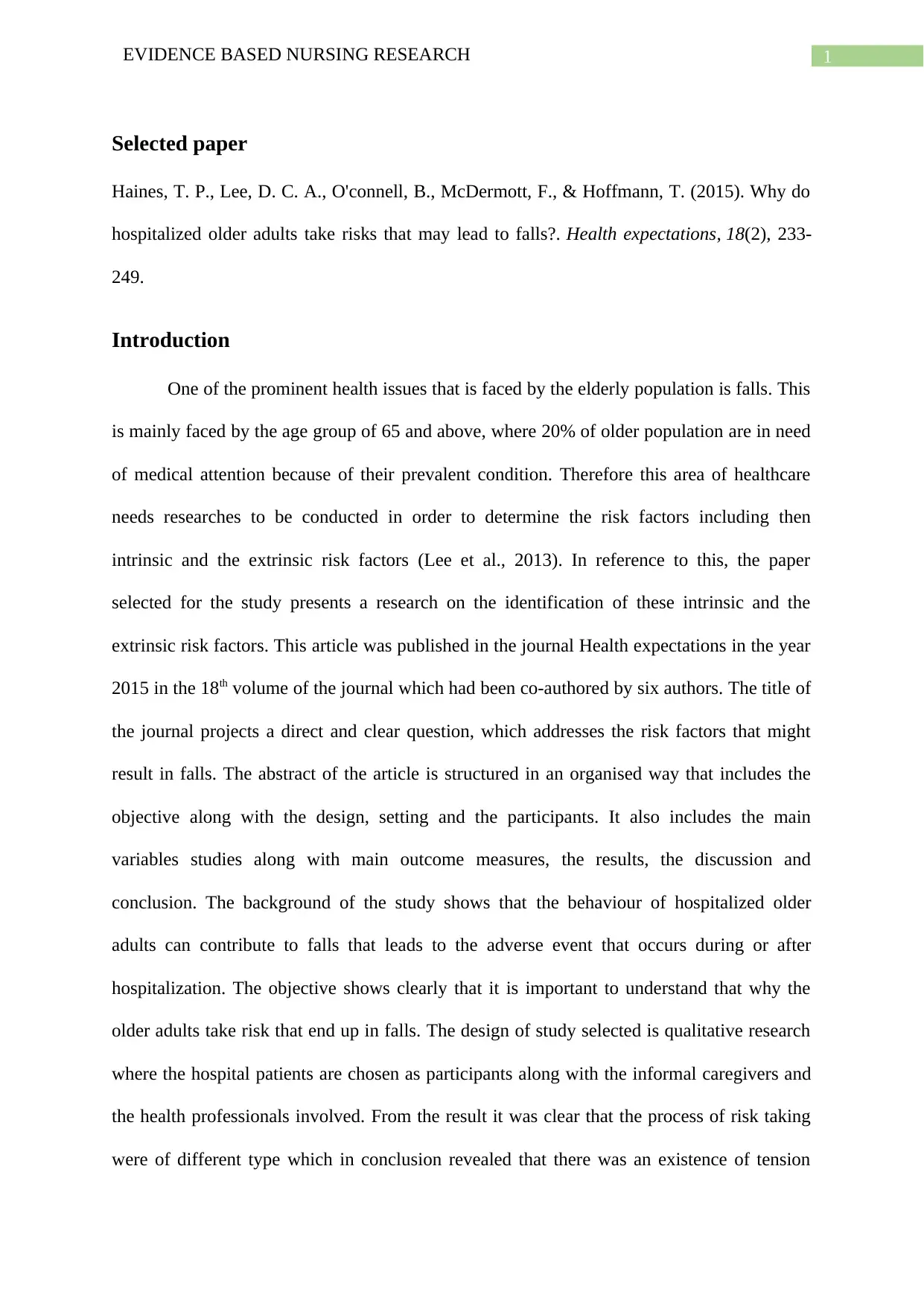
1EVIDENCE BASED NURSING RESEARCH
Selected paper
Haines, T. P., Lee, D. C. A., O'connell, B., McDermott, F., & Hoffmann, T. (2015). Why do
hospitalized older adults take risks that may lead to falls?. Health expectations, 18(2), 233-
249.
Introduction
One of the prominent health issues that is faced by the elderly population is falls. This
is mainly faced by the age group of 65 and above, where 20% of older population are in need
of medical attention because of their prevalent condition. Therefore this area of healthcare
needs researches to be conducted in order to determine the risk factors including then
intrinsic and the extrinsic risk factors (Lee et al., 2013). In reference to this, the paper
selected for the study presents a research on the identification of these intrinsic and the
extrinsic risk factors. This article was published in the journal Health expectations in the year
2015 in the 18th volume of the journal which had been co-authored by six authors. The title of
the journal projects a direct and clear question, which addresses the risk factors that might
result in falls. The abstract of the article is structured in an organised way that includes the
objective along with the design, setting and the participants. It also includes the main
variables studies along with main outcome measures, the results, the discussion and
conclusion. The background of the study shows that the behaviour of hospitalized older
adults can contribute to falls that leads to the adverse event that occurs during or after
hospitalization. The objective shows clearly that it is important to understand that why the
older adults take risk that end up in falls. The design of study selected is qualitative research
where the hospital patients are chosen as participants along with the informal caregivers and
the health professionals involved. From the result it was clear that the process of risk taking
were of different type which in conclusion revealed that there was an existence of tension
Selected paper
Haines, T. P., Lee, D. C. A., O'connell, B., McDermott, F., & Hoffmann, T. (2015). Why do
hospitalized older adults take risks that may lead to falls?. Health expectations, 18(2), 233-
249.
Introduction
One of the prominent health issues that is faced by the elderly population is falls. This
is mainly faced by the age group of 65 and above, where 20% of older population are in need
of medical attention because of their prevalent condition. Therefore this area of healthcare
needs researches to be conducted in order to determine the risk factors including then
intrinsic and the extrinsic risk factors (Lee et al., 2013). In reference to this, the paper
selected for the study presents a research on the identification of these intrinsic and the
extrinsic risk factors. This article was published in the journal Health expectations in the year
2015 in the 18th volume of the journal which had been co-authored by six authors. The title of
the journal projects a direct and clear question, which addresses the risk factors that might
result in falls. The abstract of the article is structured in an organised way that includes the
objective along with the design, setting and the participants. It also includes the main
variables studies along with main outcome measures, the results, the discussion and
conclusion. The background of the study shows that the behaviour of hospitalized older
adults can contribute to falls that leads to the adverse event that occurs during or after
hospitalization. The objective shows clearly that it is important to understand that why the
older adults take risk that end up in falls. The design of study selected is qualitative research
where the hospital patients are chosen as participants along with the informal caregivers and
the health professionals involved. From the result it was clear that the process of risk taking
were of different type which in conclusion revealed that there was an existence of tension
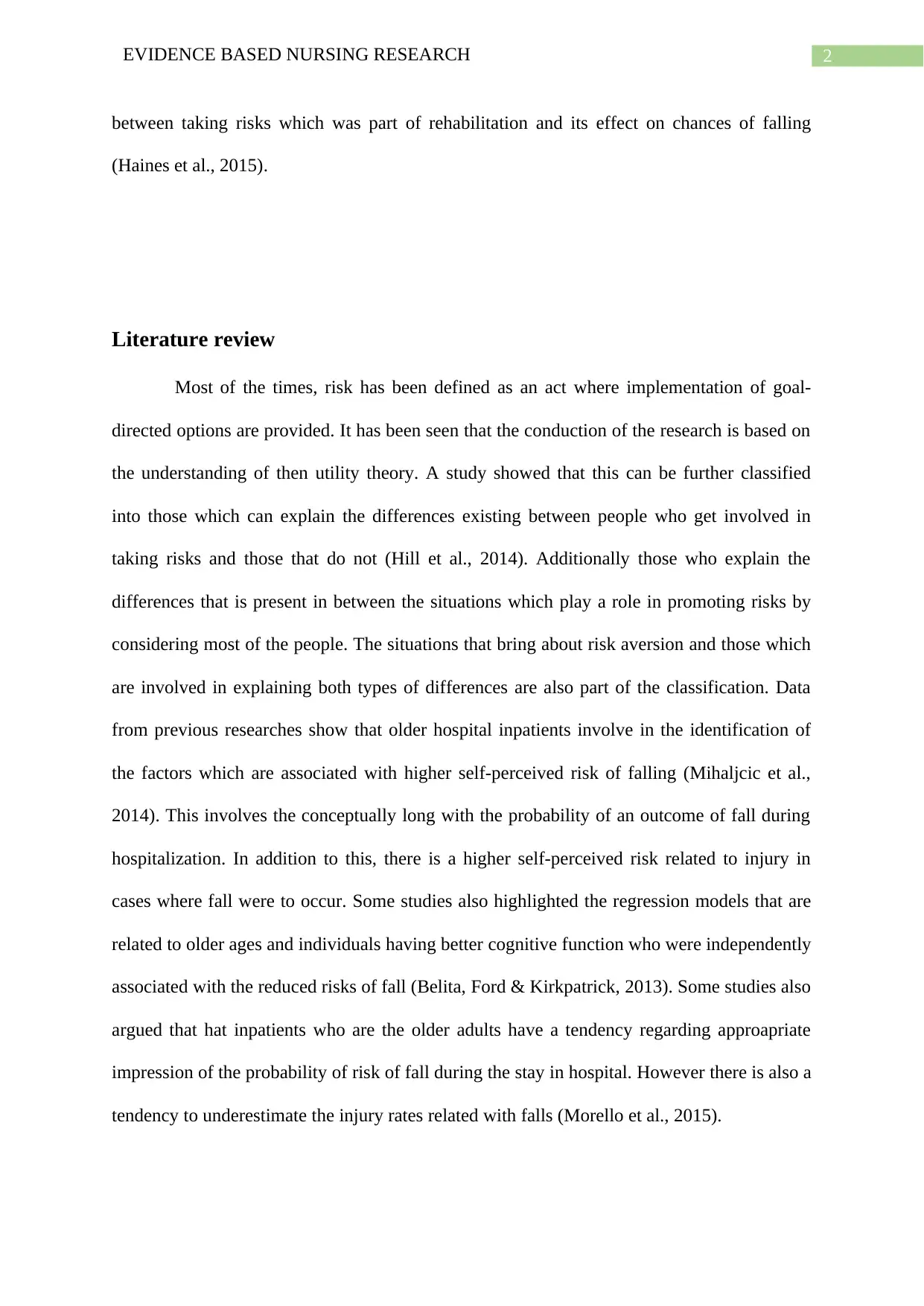
2EVIDENCE BASED NURSING RESEARCH
between taking risks which was part of rehabilitation and its effect on chances of falling
(Haines et al., 2015).
Literature review
Most of the times, risk has been defined as an act where implementation of goal-
directed options are provided. It has been seen that the conduction of the research is based on
the understanding of then utility theory. A study showed that this can be further classified
into those which can explain the differences existing between people who get involved in
taking risks and those that do not (Hill et al., 2014). Additionally those who explain the
differences that is present in between the situations which play a role in promoting risks by
considering most of the people. The situations that bring about risk aversion and those which
are involved in explaining both types of differences are also part of the classification. Data
from previous researches show that older hospital inpatients involve in the identification of
the factors which are associated with higher self-perceived risk of falling (Mihaljcic et al.,
2014). This involves the conceptually long with the probability of an outcome of fall during
hospitalization. In addition to this, there is a higher self-perceived risk related to injury in
cases where fall were to occur. Some studies also highlighted the regression models that are
related to older ages and individuals having better cognitive function who were independently
associated with the reduced risks of fall (Belita, Ford & Kirkpatrick, 2013). Some studies also
argued that hat inpatients who are the older adults have a tendency regarding approapriate
impression of the probability of risk of fall during the stay in hospital. However there is also a
tendency to underestimate the injury rates related with falls (Morello et al., 2015).
between taking risks which was part of rehabilitation and its effect on chances of falling
(Haines et al., 2015).
Literature review
Most of the times, risk has been defined as an act where implementation of goal-
directed options are provided. It has been seen that the conduction of the research is based on
the understanding of then utility theory. A study showed that this can be further classified
into those which can explain the differences existing between people who get involved in
taking risks and those that do not (Hill et al., 2014). Additionally those who explain the
differences that is present in between the situations which play a role in promoting risks by
considering most of the people. The situations that bring about risk aversion and those which
are involved in explaining both types of differences are also part of the classification. Data
from previous researches show that older hospital inpatients involve in the identification of
the factors which are associated with higher self-perceived risk of falling (Mihaljcic et al.,
2014). This involves the conceptually long with the probability of an outcome of fall during
hospitalization. In addition to this, there is a higher self-perceived risk related to injury in
cases where fall were to occur. Some studies also highlighted the regression models that are
related to older ages and individuals having better cognitive function who were independently
associated with the reduced risks of fall (Belita, Ford & Kirkpatrick, 2013). Some studies also
argued that hat inpatients who are the older adults have a tendency regarding approapriate
impression of the probability of risk of fall during the stay in hospital. However there is also a
tendency to underestimate the injury rates related with falls (Morello et al., 2015).
⊘ This is a preview!⊘
Do you want full access?
Subscribe today to unlock all pages.

Trusted by 1+ million students worldwide
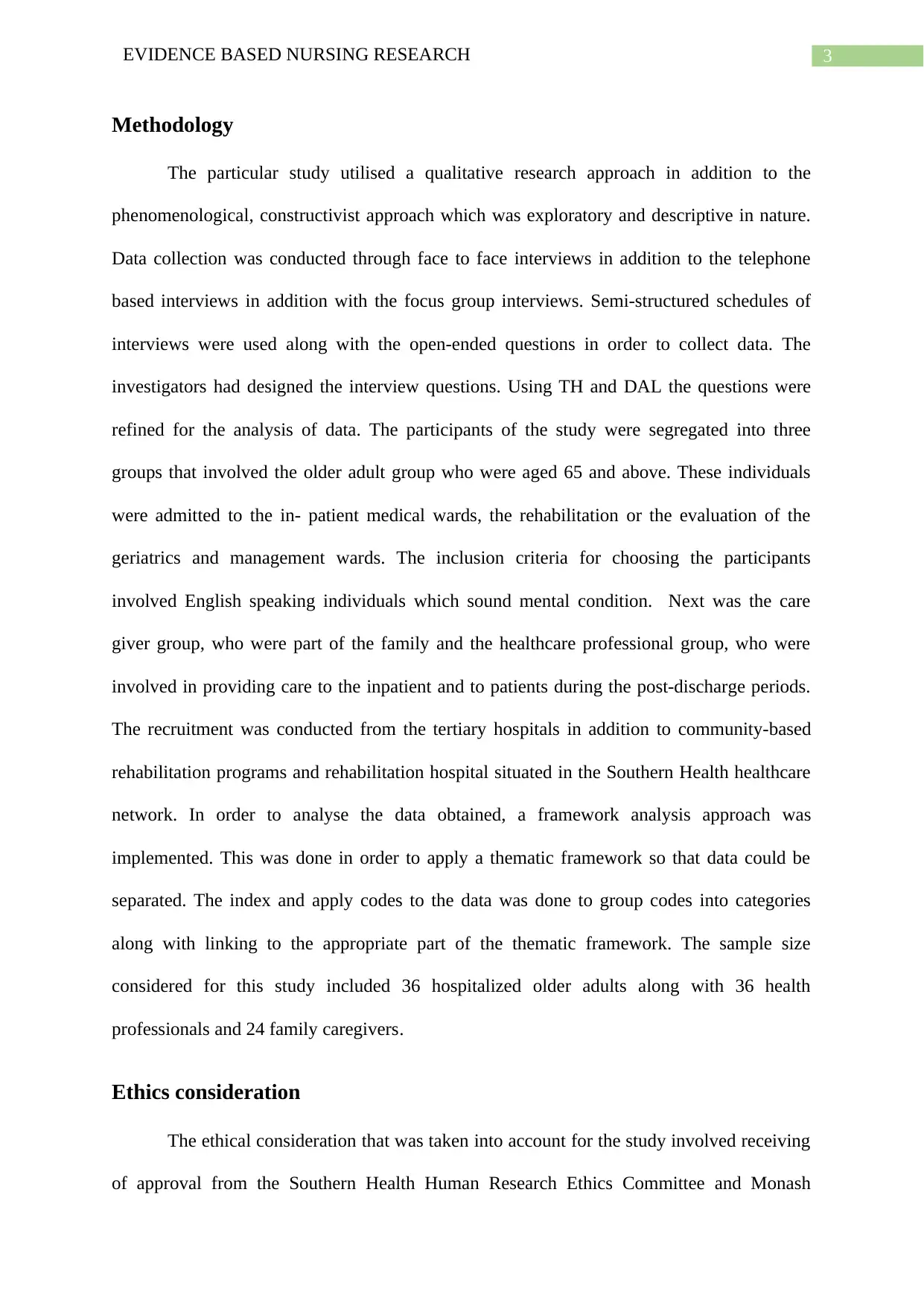
3EVIDENCE BASED NURSING RESEARCH
Methodology
The particular study utilised a qualitative research approach in addition to the
phenomenological, constructivist approach which was exploratory and descriptive in nature.
Data collection was conducted through face to face interviews in addition to the telephone
based interviews in addition with the focus group interviews. Semi-structured schedules of
interviews were used along with the open-ended questions in order to collect data. The
investigators had designed the interview questions. Using TH and DAL the questions were
refined for the analysis of data. The participants of the study were segregated into three
groups that involved the older adult group who were aged 65 and above. These individuals
were admitted to the in- patient medical wards, the rehabilitation or the evaluation of the
geriatrics and management wards. The inclusion criteria for choosing the participants
involved English speaking individuals which sound mental condition. Next was the care
giver group, who were part of the family and the healthcare professional group, who were
involved in providing care to the inpatient and to patients during the post-discharge periods.
The recruitment was conducted from the tertiary hospitals in addition to community-based
rehabilitation programs and rehabilitation hospital situated in the Southern Health healthcare
network. In order to analyse the data obtained, a framework analysis approach was
implemented. This was done in order to apply a thematic framework so that data could be
separated. The index and apply codes to the data was done to group codes into categories
along with linking to the appropriate part of the thematic framework. The sample size
considered for this study included 36 hospitalized older adults along with 36 health
professionals and 24 family caregivers.
Ethics consideration
The ethical consideration that was taken into account for the study involved receiving
of approval from the Southern Health Human Research Ethics Committee and Monash
Methodology
The particular study utilised a qualitative research approach in addition to the
phenomenological, constructivist approach which was exploratory and descriptive in nature.
Data collection was conducted through face to face interviews in addition to the telephone
based interviews in addition with the focus group interviews. Semi-structured schedules of
interviews were used along with the open-ended questions in order to collect data. The
investigators had designed the interview questions. Using TH and DAL the questions were
refined for the analysis of data. The participants of the study were segregated into three
groups that involved the older adult group who were aged 65 and above. These individuals
were admitted to the in- patient medical wards, the rehabilitation or the evaluation of the
geriatrics and management wards. The inclusion criteria for choosing the participants
involved English speaking individuals which sound mental condition. Next was the care
giver group, who were part of the family and the healthcare professional group, who were
involved in providing care to the inpatient and to patients during the post-discharge periods.
The recruitment was conducted from the tertiary hospitals in addition to community-based
rehabilitation programs and rehabilitation hospital situated in the Southern Health healthcare
network. In order to analyse the data obtained, a framework analysis approach was
implemented. This was done in order to apply a thematic framework so that data could be
separated. The index and apply codes to the data was done to group codes into categories
along with linking to the appropriate part of the thematic framework. The sample size
considered for this study included 36 hospitalized older adults along with 36 health
professionals and 24 family caregivers.
Ethics consideration
The ethical consideration that was taken into account for the study involved receiving
of approval from the Southern Health Human Research Ethics Committee and Monash
Paraphrase This Document
Need a fresh take? Get an instant paraphrase of this document with our AI Paraphraser
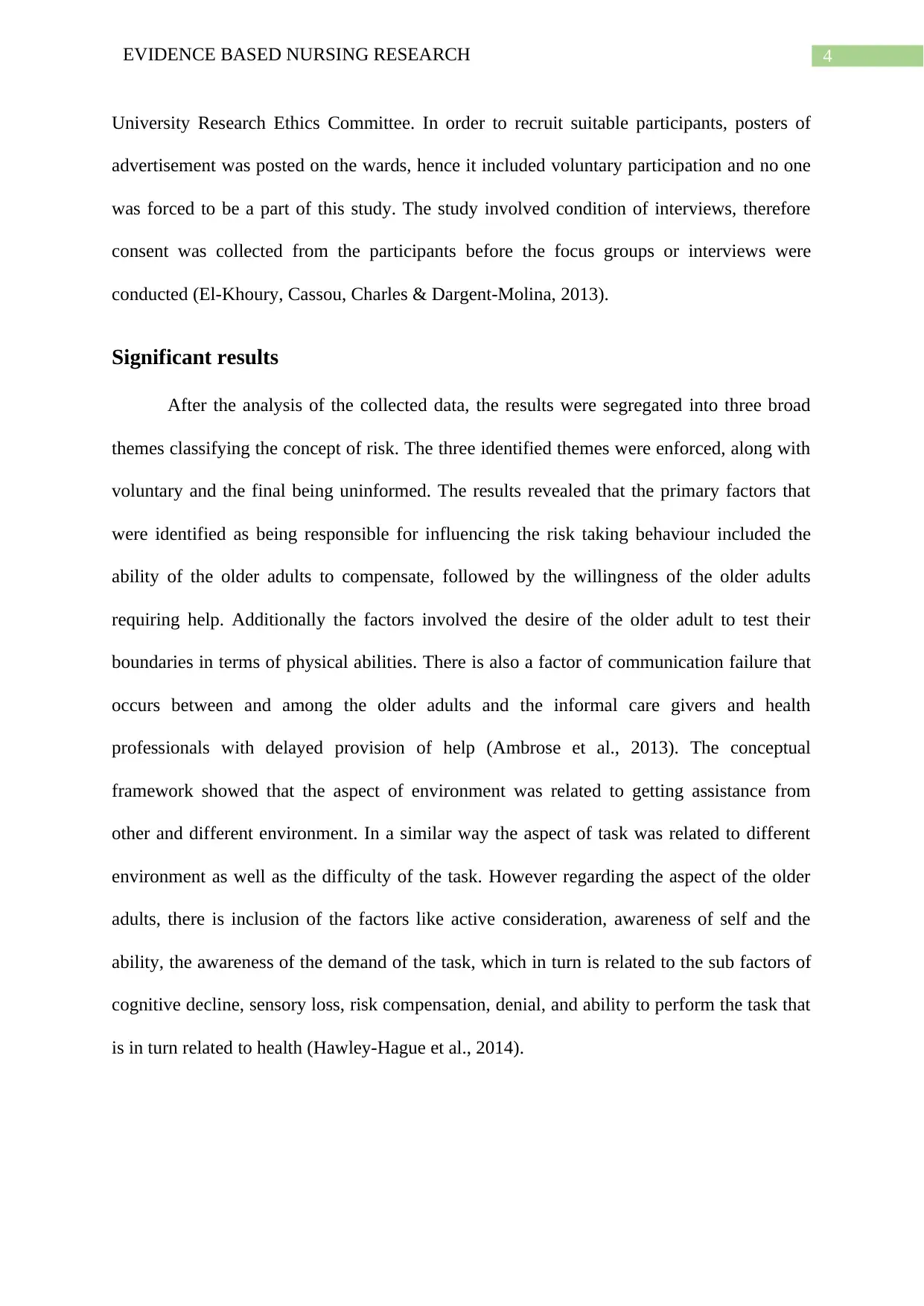
4EVIDENCE BASED NURSING RESEARCH
University Research Ethics Committee. In order to recruit suitable participants, posters of
advertisement was posted on the wards, hence it included voluntary participation and no one
was forced to be a part of this study. The study involved condition of interviews, therefore
consent was collected from the participants before the focus groups or interviews were
conducted (El-Khoury, Cassou, Charles & Dargent-Molina, 2013).
Significant results
After the analysis of the collected data, the results were segregated into three broad
themes classifying the concept of risk. The three identified themes were enforced, along with
voluntary and the final being uninformed. The results revealed that the primary factors that
were identified as being responsible for influencing the risk taking behaviour included the
ability of the older adults to compensate, followed by the willingness of the older adults
requiring help. Additionally the factors involved the desire of the older adult to test their
boundaries in terms of physical abilities. There is also a factor of communication failure that
occurs between and among the older adults and the informal care givers and health
professionals with delayed provision of help (Ambrose et al., 2013). The conceptual
framework showed that the aspect of environment was related to getting assistance from
other and different environment. In a similar way the aspect of task was related to different
environment as well as the difficulty of the task. However regarding the aspect of the older
adults, there is inclusion of the factors like active consideration, awareness of self and the
ability, the awareness of the demand of the task, which in turn is related to the sub factors of
cognitive decline, sensory loss, risk compensation, denial, and ability to perform the task that
is in turn related to health (Hawley-Hague et al., 2014).
University Research Ethics Committee. In order to recruit suitable participants, posters of
advertisement was posted on the wards, hence it included voluntary participation and no one
was forced to be a part of this study. The study involved condition of interviews, therefore
consent was collected from the participants before the focus groups or interviews were
conducted (El-Khoury, Cassou, Charles & Dargent-Molina, 2013).
Significant results
After the analysis of the collected data, the results were segregated into three broad
themes classifying the concept of risk. The three identified themes were enforced, along with
voluntary and the final being uninformed. The results revealed that the primary factors that
were identified as being responsible for influencing the risk taking behaviour included the
ability of the older adults to compensate, followed by the willingness of the older adults
requiring help. Additionally the factors involved the desire of the older adult to test their
boundaries in terms of physical abilities. There is also a factor of communication failure that
occurs between and among the older adults and the informal care givers and health
professionals with delayed provision of help (Ambrose et al., 2013). The conceptual
framework showed that the aspect of environment was related to getting assistance from
other and different environment. In a similar way the aspect of task was related to different
environment as well as the difficulty of the task. However regarding the aspect of the older
adults, there is inclusion of the factors like active consideration, awareness of self and the
ability, the awareness of the demand of the task, which in turn is related to the sub factors of
cognitive decline, sensory loss, risk compensation, denial, and ability to perform the task that
is in turn related to health (Hawley-Hague et al., 2014).
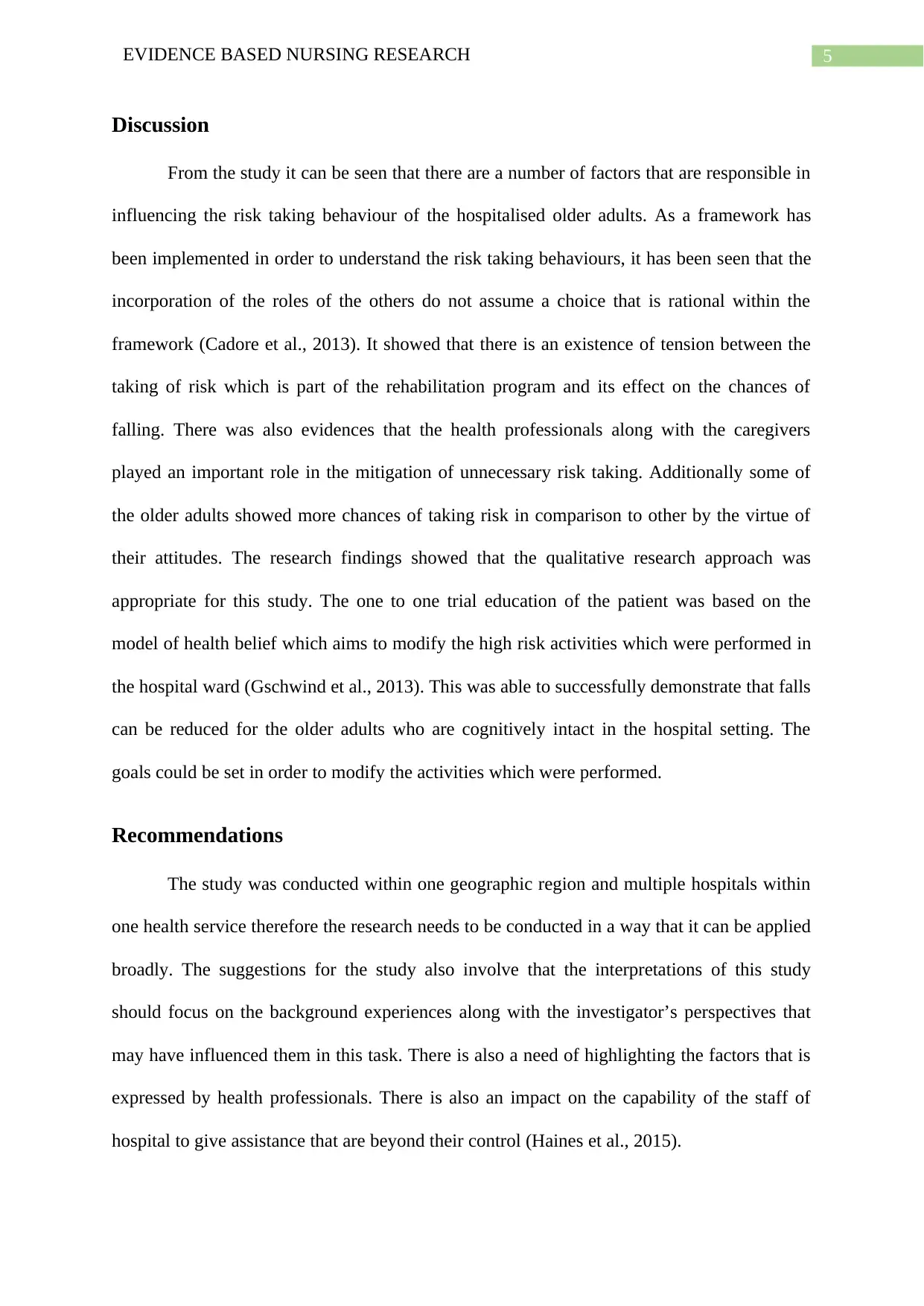
5EVIDENCE BASED NURSING RESEARCH
Discussion
From the study it can be seen that there are a number of factors that are responsible in
influencing the risk taking behaviour of the hospitalised older adults. As a framework has
been implemented in order to understand the risk taking behaviours, it has been seen that the
incorporation of the roles of the others do not assume a choice that is rational within the
framework (Cadore et al., 2013). It showed that there is an existence of tension between the
taking of risk which is part of the rehabilitation program and its effect on the chances of
falling. There was also evidences that the health professionals along with the caregivers
played an important role in the mitigation of unnecessary risk taking. Additionally some of
the older adults showed more chances of taking risk in comparison to other by the virtue of
their attitudes. The research findings showed that the qualitative research approach was
appropriate for this study. The one to one trial education of the patient was based on the
model of health belief which aims to modify the high risk activities which were performed in
the hospital ward (Gschwind et al., 2013). This was able to successfully demonstrate that falls
can be reduced for the older adults who are cognitively intact in the hospital setting. The
goals could be set in order to modify the activities which were performed.
Recommendations
The study was conducted within one geographic region and multiple hospitals within
one health service therefore the research needs to be conducted in a way that it can be applied
broadly. The suggestions for the study also involve that the interpretations of this study
should focus on the background experiences along with the investigator’s perspectives that
may have influenced them in this task. There is also a need of highlighting the factors that is
expressed by health professionals. There is also an impact on the capability of the staff of
hospital to give assistance that are beyond their control (Haines et al., 2015).
Discussion
From the study it can be seen that there are a number of factors that are responsible in
influencing the risk taking behaviour of the hospitalised older adults. As a framework has
been implemented in order to understand the risk taking behaviours, it has been seen that the
incorporation of the roles of the others do not assume a choice that is rational within the
framework (Cadore et al., 2013). It showed that there is an existence of tension between the
taking of risk which is part of the rehabilitation program and its effect on the chances of
falling. There was also evidences that the health professionals along with the caregivers
played an important role in the mitigation of unnecessary risk taking. Additionally some of
the older adults showed more chances of taking risk in comparison to other by the virtue of
their attitudes. The research findings showed that the qualitative research approach was
appropriate for this study. The one to one trial education of the patient was based on the
model of health belief which aims to modify the high risk activities which were performed in
the hospital ward (Gschwind et al., 2013). This was able to successfully demonstrate that falls
can be reduced for the older adults who are cognitively intact in the hospital setting. The
goals could be set in order to modify the activities which were performed.
Recommendations
The study was conducted within one geographic region and multiple hospitals within
one health service therefore the research needs to be conducted in a way that it can be applied
broadly. The suggestions for the study also involve that the interpretations of this study
should focus on the background experiences along with the investigator’s perspectives that
may have influenced them in this task. There is also a need of highlighting the factors that is
expressed by health professionals. There is also an impact on the capability of the staff of
hospital to give assistance that are beyond their control (Haines et al., 2015).
⊘ This is a preview!⊘
Do you want full access?
Subscribe today to unlock all pages.

Trusted by 1+ million students worldwide
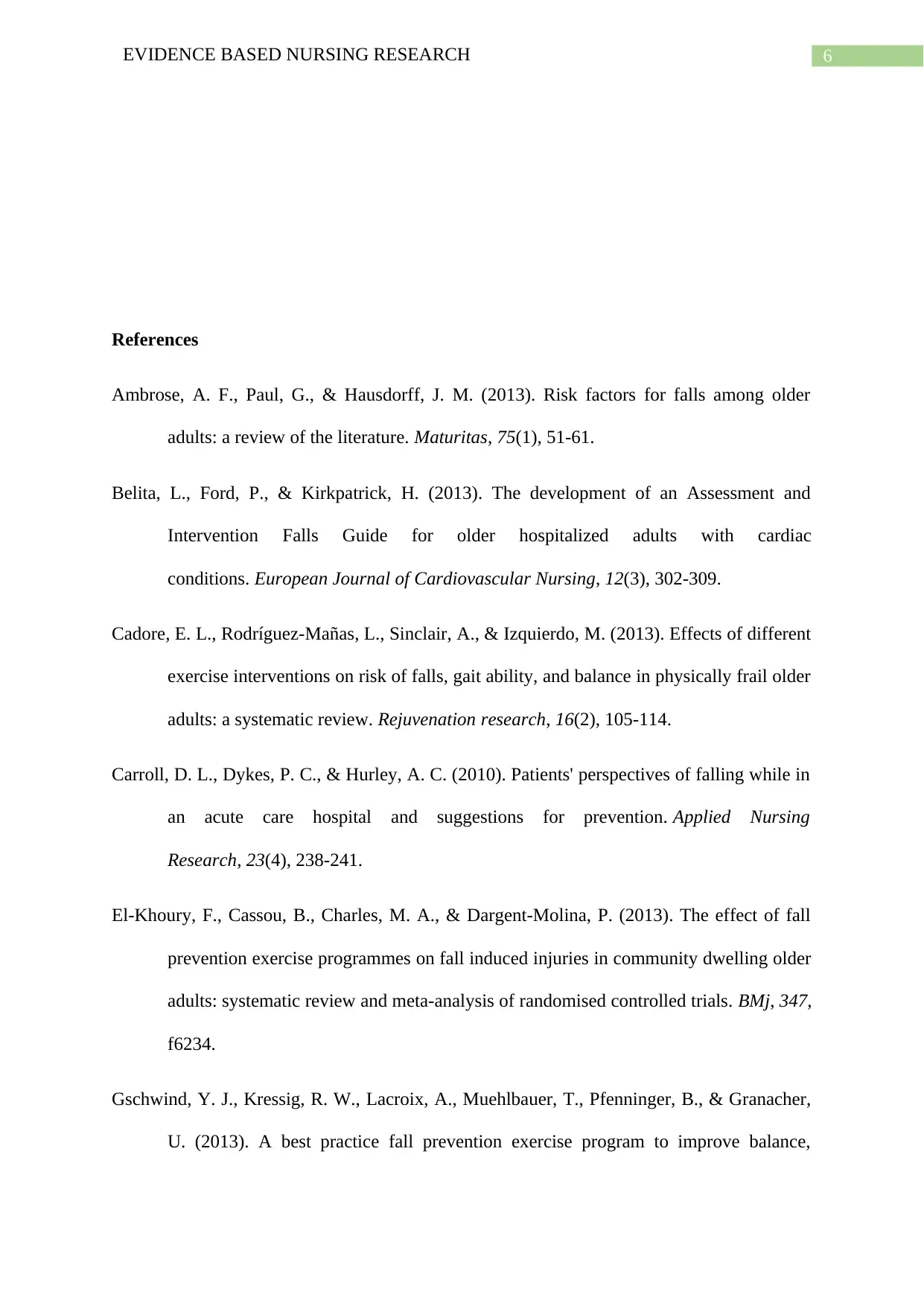
6EVIDENCE BASED NURSING RESEARCH
References
Ambrose, A. F., Paul, G., & Hausdorff, J. M. (2013). Risk factors for falls among older
adults: a review of the literature. Maturitas, 75(1), 51-61.
Belita, L., Ford, P., & Kirkpatrick, H. (2013). The development of an Assessment and
Intervention Falls Guide for older hospitalized adults with cardiac
conditions. European Journal of Cardiovascular Nursing, 12(3), 302-309.
Cadore, E. L., Rodríguez-Mañas, L., Sinclair, A., & Izquierdo, M. (2013). Effects of different
exercise interventions on risk of falls, gait ability, and balance in physically frail older
adults: a systematic review. Rejuvenation research, 16(2), 105-114.
Carroll, D. L., Dykes, P. C., & Hurley, A. C. (2010). Patients' perspectives of falling while in
an acute care hospital and suggestions for prevention. Applied Nursing
Research, 23(4), 238-241.
El-Khoury, F., Cassou, B., Charles, M. A., & Dargent-Molina, P. (2013). The effect of fall
prevention exercise programmes on fall induced injuries in community dwelling older
adults: systematic review and meta-analysis of randomised controlled trials. BMj, 347,
f6234.
Gschwind, Y. J., Kressig, R. W., Lacroix, A., Muehlbauer, T., Pfenninger, B., & Granacher,
U. (2013). A best practice fall prevention exercise program to improve balance,
References
Ambrose, A. F., Paul, G., & Hausdorff, J. M. (2013). Risk factors for falls among older
adults: a review of the literature. Maturitas, 75(1), 51-61.
Belita, L., Ford, P., & Kirkpatrick, H. (2013). The development of an Assessment and
Intervention Falls Guide for older hospitalized adults with cardiac
conditions. European Journal of Cardiovascular Nursing, 12(3), 302-309.
Cadore, E. L., Rodríguez-Mañas, L., Sinclair, A., & Izquierdo, M. (2013). Effects of different
exercise interventions on risk of falls, gait ability, and balance in physically frail older
adults: a systematic review. Rejuvenation research, 16(2), 105-114.
Carroll, D. L., Dykes, P. C., & Hurley, A. C. (2010). Patients' perspectives of falling while in
an acute care hospital and suggestions for prevention. Applied Nursing
Research, 23(4), 238-241.
El-Khoury, F., Cassou, B., Charles, M. A., & Dargent-Molina, P. (2013). The effect of fall
prevention exercise programmes on fall induced injuries in community dwelling older
adults: systematic review and meta-analysis of randomised controlled trials. BMj, 347,
f6234.
Gschwind, Y. J., Kressig, R. W., Lacroix, A., Muehlbauer, T., Pfenninger, B., & Granacher,
U. (2013). A best practice fall prevention exercise program to improve balance,
Paraphrase This Document
Need a fresh take? Get an instant paraphrase of this document with our AI Paraphraser
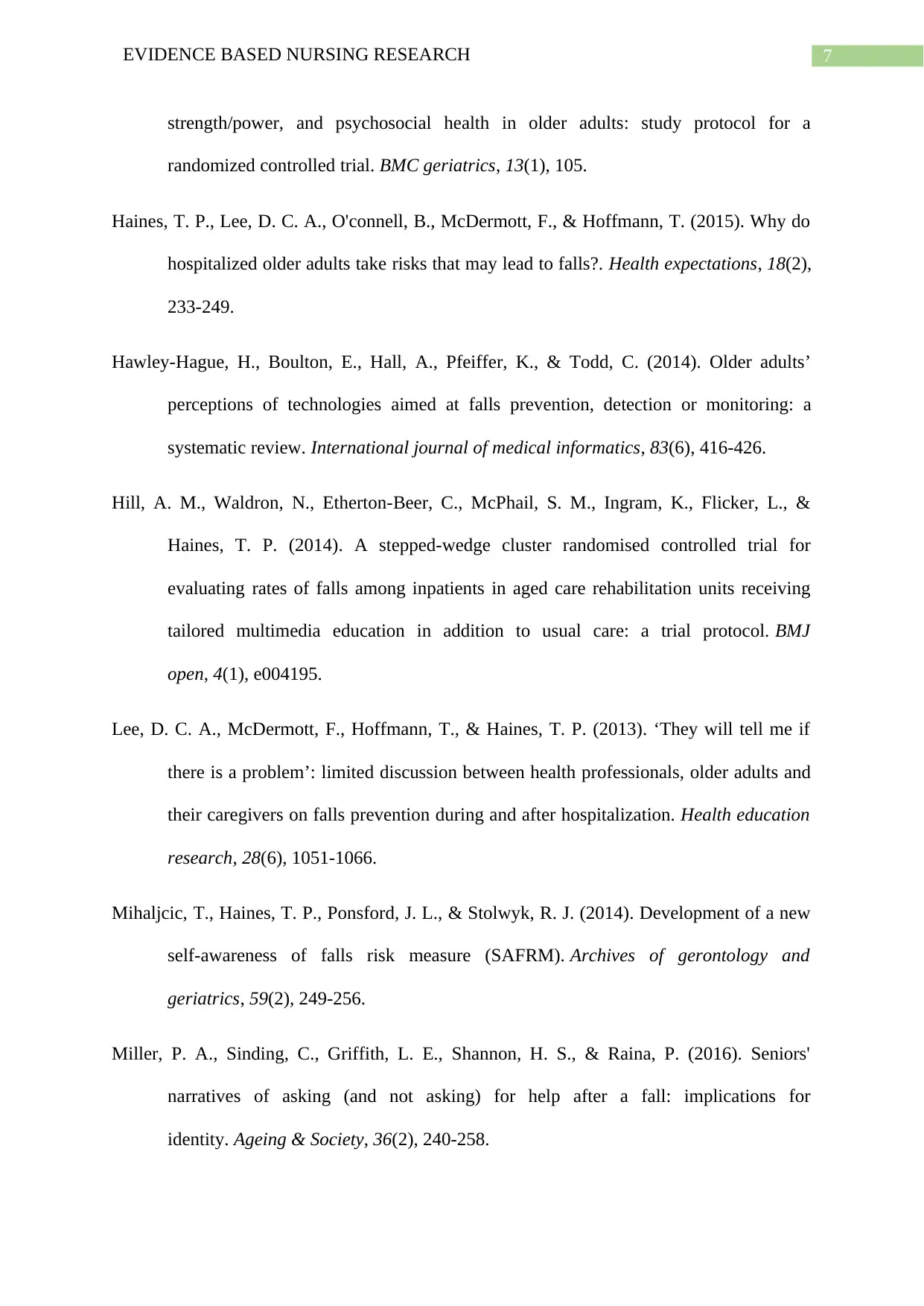
7EVIDENCE BASED NURSING RESEARCH
strength/power, and psychosocial health in older adults: study protocol for a
randomized controlled trial. BMC geriatrics, 13(1), 105.
Haines, T. P., Lee, D. C. A., O'connell, B., McDermott, F., & Hoffmann, T. (2015). Why do
hospitalized older adults take risks that may lead to falls?. Health expectations, 18(2),
233-249.
Hawley-Hague, H., Boulton, E., Hall, A., Pfeiffer, K., & Todd, C. (2014). Older adults’
perceptions of technologies aimed at falls prevention, detection or monitoring: a
systematic review. International journal of medical informatics, 83(6), 416-426.
Hill, A. M., Waldron, N., Etherton-Beer, C., McPhail, S. M., Ingram, K., Flicker, L., &
Haines, T. P. (2014). A stepped-wedge cluster randomised controlled trial for
evaluating rates of falls among inpatients in aged care rehabilitation units receiving
tailored multimedia education in addition to usual care: a trial protocol. BMJ
open, 4(1), e004195.
Lee, D. C. A., McDermott, F., Hoffmann, T., & Haines, T. P. (2013). ‘They will tell me if
there is a problem’: limited discussion between health professionals, older adults and
their caregivers on falls prevention during and after hospitalization. Health education
research, 28(6), 1051-1066.
Mihaljcic, T., Haines, T. P., Ponsford, J. L., & Stolwyk, R. J. (2014). Development of a new
self-awareness of falls risk measure (SAFRM). Archives of gerontology and
geriatrics, 59(2), 249-256.
Miller, P. A., Sinding, C., Griffith, L. E., Shannon, H. S., & Raina, P. (2016). Seniors'
narratives of asking (and not asking) for help after a fall: implications for
identity. Ageing & Society, 36(2), 240-258.
strength/power, and psychosocial health in older adults: study protocol for a
randomized controlled trial. BMC geriatrics, 13(1), 105.
Haines, T. P., Lee, D. C. A., O'connell, B., McDermott, F., & Hoffmann, T. (2015). Why do
hospitalized older adults take risks that may lead to falls?. Health expectations, 18(2),
233-249.
Hawley-Hague, H., Boulton, E., Hall, A., Pfeiffer, K., & Todd, C. (2014). Older adults’
perceptions of technologies aimed at falls prevention, detection or monitoring: a
systematic review. International journal of medical informatics, 83(6), 416-426.
Hill, A. M., Waldron, N., Etherton-Beer, C., McPhail, S. M., Ingram, K., Flicker, L., &
Haines, T. P. (2014). A stepped-wedge cluster randomised controlled trial for
evaluating rates of falls among inpatients in aged care rehabilitation units receiving
tailored multimedia education in addition to usual care: a trial protocol. BMJ
open, 4(1), e004195.
Lee, D. C. A., McDermott, F., Hoffmann, T., & Haines, T. P. (2013). ‘They will tell me if
there is a problem’: limited discussion between health professionals, older adults and
their caregivers on falls prevention during and after hospitalization. Health education
research, 28(6), 1051-1066.
Mihaljcic, T., Haines, T. P., Ponsford, J. L., & Stolwyk, R. J. (2014). Development of a new
self-awareness of falls risk measure (SAFRM). Archives of gerontology and
geriatrics, 59(2), 249-256.
Miller, P. A., Sinding, C., Griffith, L. E., Shannon, H. S., & Raina, P. (2016). Seniors'
narratives of asking (and not asking) for help after a fall: implications for
identity. Ageing & Society, 36(2), 240-258.
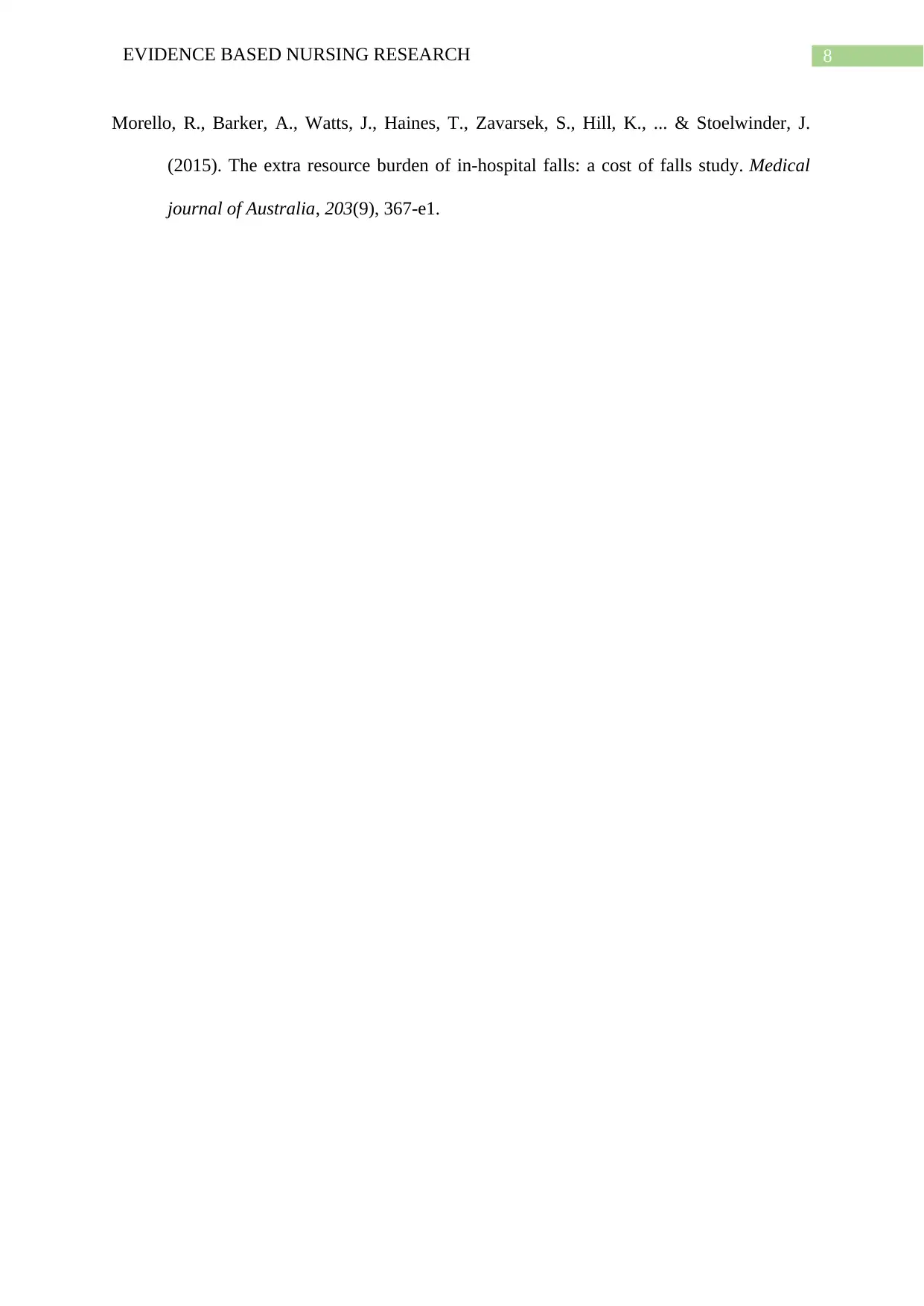
8EVIDENCE BASED NURSING RESEARCH
Morello, R., Barker, A., Watts, J., Haines, T., Zavarsek, S., Hill, K., ... & Stoelwinder, J.
(2015). The extra resource burden of in-hospital falls: a cost of falls study. Medical
journal of Australia, 203(9), 367-e1.
Morello, R., Barker, A., Watts, J., Haines, T., Zavarsek, S., Hill, K., ... & Stoelwinder, J.
(2015). The extra resource burden of in-hospital falls: a cost of falls study. Medical
journal of Australia, 203(9), 367-e1.
⊘ This is a preview!⊘
Do you want full access?
Subscribe today to unlock all pages.

Trusted by 1+ million students worldwide
1 out of 9
Related Documents
Your All-in-One AI-Powered Toolkit for Academic Success.
+13062052269
info@desklib.com
Available 24*7 on WhatsApp / Email
![[object Object]](/_next/static/media/star-bottom.7253800d.svg)
Unlock your academic potential
Copyright © 2020–2025 A2Z Services. All Rights Reserved. Developed and managed by ZUCOL.




